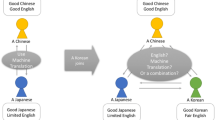Abstract
When applying Language Grid for multilingual communication support, it is important to understand the effects of the machine translation service. To support the users in multilingual communication, it is recognized that machine translation service used is not a perfect transparent-channel to users. We present agent metaphor as a novel interactive way to promote the efficiency of communication in using machine translation service. It will reduce the communication breaks caused by translation errors. We propose to shift from the transparent-channel metaphor to the agent metaphor, which motives the interactions between the users and the machine translator. Following this paradigm shifting, the agent should encourage the dialog participants to collaborate, as their interactivity will be helpful in reducing the number of translation errors. We examined the translation issues raised by multilingual communication, and analyzed the impact of interactivity on the elimination of translation errors. We proposed an implementation of the agent protocol for interactivity promotion. We designed the architecture of our agent, analyzed the interaction process, and provided an example of preparing repair strategy. We conducted an English–Chinese communication task experiment on tangram arrangement. The experiment shows that compared to the transparent-channel metaphor, our agent metaphor reduces human communication effort by 21.6%.
Access this chapter
Tax calculation will be finalised at checkout
Purchases are for personal use only
Similar content being viewed by others
References
AECMA: A Guide for the Preparation of Aircraft Maintenance Documentation in the Aerospace Maintenance Language. AECMA Simplified English. Brussels (1995)
Callison-Burch, C., Koehn, P., Osborne, M.: Improved statistical machine translation using paraphrases. Proceedings of the HLT-NAACL 2006, 17–24 (2006)
Carl, M., Way, A., Schler, R.: Toward a hybrid integrated translation environment. Machine Translation: From Research to Real Users. Lecture Notes in Computer Science, vol. 2499, pp. 11–20. Springer, Berlin / Heidelberg (2002)
Goodwin, C., Heritage, J.: Conversation analysis. Annual Review of Anthropology 19, 283–307 (1990)
Hu, C., Bederson, B.B., Resnik, P., Kronrod, Y.: Monotrans2: a new human computation system to support monolingual translation. In: Proceedings of the CHI 2011, pp. 1133–1136. ACM (2011)
Ishida, T.: Communicating culture. IEEE Intelligent Systems, Special issue on the Future of AI 21(3), 62–63 (2006)
Ishida, T. (ed.): The language grid: Service-oriented collective intelligence for language resource interoperability. Springer Science & Business Media (2011)
Ishida, T.: Intercultural Collaboration and Support Systems: A Brief History. International Conference on Principle and Practices in Multi-Agent Systems (PRIMA 2016). Invited paper, pp. 3–19 (2016)
Klein, D., Manning, C.D.: Fast exact inference with a factored model for natural language parsing. In: In Advances in Neural Information Processing Systems 15 (NIPS, pp. 3–10. MIT Press (2003)
Lemerise, E.A., Arsenio, W.F.: An integrated model of emotion processes and cognition in social information processing. Child Development 71(1), 107–118 (2000)
Lin, D., Ishida, T., Murakami, Y., Tanaka, M.: Qos analysis for service composition by human and web services. IEICE Transactions on Information and Systems E97.D(4), 762–769 (2014)
Miyabe, M., Yoshino, T.: Accuracy evaluation of sentences translated to intermediate language in back translation. In: Proceedings of IUCS 2009, pp. 30–35. ACM (2009)
Miyabe, M., Yoshino, T., Shigenobu, T.: Effects of repair support agent for accurate multilingual communication. In: Proceedings of the PRICAI 2008: Trends in Artificial Intelligence, vol. 5351, pp. 1022–1027. Springer Berlin / Heidelberg (2008)
Morita, D., Ishida, T.: Designing protocols for collaborative translation. In: PRIMA 2009, pp. 17–32. Berlin, Heidelberg (2009)
Murakami, Y., Lin, D., Ishida, T.: Service-Oriented Architecture for Interoperability of Multilanguage Services, pp. 313–328. Springer Berlin Heidelberg, Berlin, Heidelberg (2014)
Pascual-Nieto, I., Santos, O.C., Perez-Marin, D., Boticario, J.G.: Extending computer assisted assessment systems with natural language processing, user modeling, and recommendations based on human computer interaction and data mining. Proceedings of the IJCAI 2011, 2519–2524 (2011)
Pym, P.J.: Pre-editing and the use of simplified writing for mt: an engineer’s experience of operating an mt system. In: Translating and the computer, pp. 80–96. London (1990)
Schwier, R., Misanchuk, E.: Interactive multimedia instruction. In: Englewood Cliffs, NJ: Educational Technology Publications, pp. 19–33 (1993)
Shi, C., Ishida, T., Lin, D.: Translation agent: A new metaphor for machine translation. New Generation Computing 32(2), 163–186 (2014)
Siddharthan, A., McKeown, K.: Improving multilingual summarization: using redundancy in the input to correct mt errors. Proceedings of the HLT 2005, 33–40 (2005)
Yamashita, N., Ishida, T.: Effects of machine translation on collaborative work. In: Proceedings of the 20th CSCW 2006, pp. 515–524. ACM (2006)
Acknowledgements
This research was partially supported by Service Science, Solutions and Foundation Integrated Research Program from JST RISTEX, and a Grant-in-Aid for Scientific Research (S) (24220002) from Japan Society for the Promotion of Science.
Author information
Authors and Affiliations
Corresponding author
Editor information
Editors and Affiliations
Rights and permissions
Copyright information
© 2018 Springer Nature Singapore Pte Ltd.
About this chapter
Cite this chapter
Shi, C., Ishida, T., Lin, D. (2018). Translation Agent. In: Murakami, Y., Lin, D., Ishida, T. (eds) Services Computing for Language Resources . Cognitive Technologies. Springer, Singapore. https://doi.org/10.1007/978-981-10-7793-7_11
Download citation
DOI: https://doi.org/10.1007/978-981-10-7793-7_11
Published:
Publisher Name: Springer, Singapore
Print ISBN: 978-981-10-7792-0
Online ISBN: 978-981-10-7793-7
eBook Packages: Computer ScienceComputer Science (R0)




